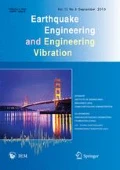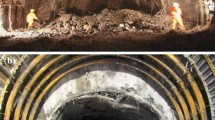Abstract
Flexibility of underground structures relative to the surrounding medium, referred to as the flexibility ratio, is an important factor that influences their dynamic interaction. This study investigates the flexibility effect of a box-shaped subway tunnel, resting directly on bedrock, on the ground surface acceleration response using a numerical model verified against dynamic centrifuge test results. A comparison of the ground surface acceleration response for tunnel models with different flexibility ratios revealed that the tunnels with different flexibility ratios influence the acceleration response at the ground surface in different ways. Tunnels with lower flexibility ratios have higher acceleration responses at short periods, whereas tunnels with higher flexibility ratios have higher acceleration responses at longer periods. The effect of the flexibility ratio on ground surface acceleration is more prominent in the high range of frequencies. Furthermore, as the flexibility ratio of the tunnel system increases, the acceleration response moves away from the free field response and shifts towards the longer periods. Therefore, the flexibility ratio of the underground tunnels influences the peak ground acceleration (PGA) at the ground surface, and may need to be considered in the seismic zonation of urban areas.
Similar content being viewed by others
References
Abuhajar O, El Naggar H and Newson T (2011), “Effects of Underground Structures on Amplification of Seismic Motion for Sand with Varying Density,” Pan-Am CGS Geotechnical Conference.
Alielahi H and Adampira M (2016), “Seismic Effects of Two-dimensional Subsurface Cavity on the Ground Motion by BEM: Amplification Patterns and Engineering Applications,” International Journal of Civil Engineering, 14(4): 233–251.
Alielahi H, Kamalian M, Asgari Marnani J, Jafari M and Panji M (2013), “Applying a Time-domain Boundary Element Method for Study of Seismic Ground Response in the Vicinity of Embedded Cylindrical Cavity,” International Journal of Civil Engineering, 11(1): 45–54.
Baziar M H, Rabeti Moghadam M, Kim D S and Choo Y W (2014), “Effect of Underground Tunnel on the Ground Surface Acceleration,” Tunnelling and Underground Space Technology, 44: 10–22.
Bilotta E, Lanzano G, Madabhushi G and Silvestri F (2014), “A Numerical Round Robin on Tunnels under Seismic Actions,” Acta Geotechnica, 9: 563–579.
Choo YW, Kim SJ, Ha JG and Kim DS (2011), “Centrifuge Modeling of Buried Box Structure Subject to Earthquake,” Proceeding of the 14th Asian Regional Conference on Soil Mechanics and Geotechnical Engineering, Hong Kong, China.
Cilingir U and Madabhushi SPG (2011a), “A Model Study on the Effects of Input Motion on the Seismic Behaviour of Tunnels,” Soil Dynamics and Earthquake Engineering, 31: 452–462.
Cilingir U and Madabhushi SPG (2011b), “Effect of Depth on Seismic Response of Circular Tunnels,” Canadian Geotechnical Journal, 48: 117–127.
Dravinski M (1983), “Ground Motion Amplification Due to Elastic Inclusions in a Halfspace,” Earthquake Engineering and Structural Dynamics, 11: 313–335.
FHWA (2009), “Technical Manual for Design and Construction of Road Tunnels-civil Elements,” Publication No. FHWA-NHI-10-034.
Garnier J (2002), “Properties of Soil Samples Used in Centrifuge Models, Physical Modelling in Geotechnics,” International Conference Physical Modelling in Geotechnics, 02: 5–19.
Ghergu M and Ionescu IR (2009), “Structure-soil-structure Coupling in Seismic Excitation and “city effect”,” Int J Eng Sci, 47: 342–354.
Green RA, Olgun CG and Cameron WI (2008), “Response and Modeling of Cantilever Retaining Walls Subjected to Seismic Motions,” Computer-Aided Civil and Infrastructure Engineering, 23: 309–322.
Hao L, Lee VW and Jianwen L (2010), “Anti-plane (SH) Waves Diffraction by an Underground Semi-circular Cavity: Analytical Solution,” Earthquake Engineering and Engineering Vibration, 9(3): 385–396.
Hashash YMA, Hook JJ, Schmidt B and Yao JIC (2001), “Seismic Design and Analysis of Underground Structures,” Tunnelling and Underground Space Technology, 16: 247–293.
Hatzigeorgiou GD and Beskos DE (2010), “Soil-structure Interaction Effects on Seismic Inelastic Analysis of 3-D Tunnels,” Soil Dynamics and Earthquake Engineering, 30(9): 851–861.
Itasca Consulting Group (2005), “FLAC -Fast Lagrangian Analysis of Continua,” Ver. 5.0 User’s Guide. Minneapolis: Itasca.
Jiang LZ, Chen J and Li J (2010), “Seismic Response of Underground Utility Tunnels: Shaking Table Testing and FEM Analysis,” Earthquake Engineering and Engineering Vibration, 9(4): 555–567.
Kim DS, Kim NR, Choo YW and Cho G Ch (2013a), “A Newly Developed State-of-the-art Geotechnical Centrifuge in Korea,” KSCE Journal of Civil Engineering, 17(1): 77–84.
Kim DS, Lee SH, Choo YW and Rames D (2013b), “Self-balanced Earthquake Simulator on Centrifuge and Dynamic Performance Verification,” KSCE Journal of Civil Engineering, 17(4): 651–661.
Kuhlemeyer RL and Lysmer J (1973), “Finite Element Method Accuracy for Wave Propagation Problems,” Journal of Soil Mechanics & Foundations, 99(5): 421–427.
Lee SH, Choo YW and Kim DS (2013), “Performance of an Equivalent Shear Beam (ESB) Model Container for Dynamic Geotechnical Centrifuge Tests,” Soil Dynamics and Earthquake Engineering, 44: 102–114.
Lee VW (1988), “Three Dimensional Diffraction of Elastic Waves by a Spherical Cavity in an Elastic Halfspace: Closed Form Solutions,” Soil Dynamics and Earthquake Engineering, 7(3): 149–161.
Migliazza M, Chiorboli M and Giani GP (2009), “Comparison of Analytical Method, 3D Finite Element Model with Experimental Subsidence Measurements Resulting from the Extension of the Milan Underground,” Computers and Geotechnics, 36: 113–124.
NCHRP (2008), REPORT 61: Seismic Analysis and Design of Retaining Walls, Buried Structures, Slopes, and Embankments, National Cooperative Highway Research Program.
Pao HY and Maw CC (1973), The Diffraction of Elastic Waves and Dynamic Stress Concentrations, Ccrane-Russak, New York.
Rabeti M and Baziar MH (2016), “Seismic Ground Motion Amplification Pattern Induced by a Subway Tunnel: Shaking Table Testing and Numerical Simulation,” Soil Dynamics and Earthquake Engineering, 83: 81–97.
Sica S, Russo AD, Rotili F and Simonelli AL (2014), “Ground Motion Amplification Due to Shallow Cavities in Nonlinear Soils,” Natural Hazards, 71: 1913–1935.
Smerzini C, Aviles J, Paolucci R and Sanchez-Sesma FJ (2009), “Effect of Underground Cavities on Surface Ground Motion under SH Wave Propagation,” Earthquake Engineering and Structural Dynamics, 38: 1441–1460.
Tsinidis G, Pitilakis K, Heron Ch and Madabhushi SP G (2013), “Experimental and Numerical Investigation of the Seismic Behavior of Rectangular Tunnels in Soft Soils,” 4th ECCOMAS Thematic Conference on Computational Methods in Structural Dynamics and Earthquake Engineering COMPDYN.
Wang J (1993), “Seismic Design of Tunnels-A Simple State-of-the-Art Design Approach,” Parsons.
Wong K C, Shah A H and Datta S K (1985), “Diffraction of Elastic Waves in a Halfspace. II. Analytical and Numerical Solutions,” Bulletin of the Seismological Society of America, 75: 69–92.
Yiouta-Mitra P, Kouretzis G, Bouckovalas G and Sofianos A (2007), “Effect of Underground Structures in Earthquake Resistant Design of Surface Structures,” ASCE GSP 160 Dynamic Response and Soil Properties, Geo-Denver: New Peaks in Geotechnics.
Yoshida N and Nakamura S (1996), “Damage to Daikai Subway Station. During The 1995 Hyogoken-Nunbu Earthquake and Its Investigation,” 11WCEE, Paper No. 2151.
Author information
Authors and Affiliations
Corresponding author
Rights and permissions
About this article
Cite this article
Baziar, M.H., Moghadam, M.R., Choo, Y.W. et al. Tunnel flexibility effect on the ground surface acceleration response. Earthq. Eng. Eng. Vib. 15, 457–476 (2016). https://doi.org/10.1007/s11803-016-0336-y
Received:
Accepted:
Published:
Issue Date:
DOI: https://doi.org/10.1007/s11803-016-0336-y




